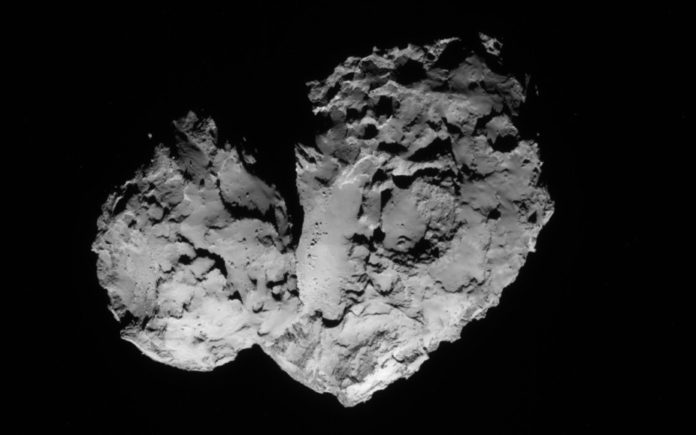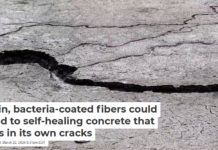
By Ian Wright, The Open University
There is much excitement about Rosetta at the moment. The European Space Agency’s spacecraft has already made a successful rendezvous with a comet and the images that are being transmitted back are simply awe-inspiring. There is much more to come – the spacecraft will ride alongside the comet for at least another year.
Meanwhile, as early as November, there will be an attempt to put a lander, nicknamed Philae, on the surface of the comet, continuing the string of mission-firsts for Rosetta. The images taken by Rosetta have narrowed down the potential landing sites to five.

Philae’s candidate landing sites.
ESA/Rosetta/MPS, CC BY
The 100kg lander has ten delicate instruments on board to record data. Choosing a land site is a complex task for many reasons. First and foremost, the site must be safe enough for landing without any damage. Next, the site must allow for good communication with Rosetta, which will eventually transmit data back to the Earth. Finally, it must also be illuminated by the sun’s faint light so that Philae can charge its batteries.
Why take the trouble
None of this is easy or cheap. So why take the trouble? There are two main reasons for humanity to pursue such challenging ventures. First there is the opportunity to develop capability. It seems clear that the era of space tourism and mining asteroids is not that far away. This “wild west” opportunity will require engineering solutions along with the availability of relevant human capital – Rosetta will inspire or supply some of these. And for those of us who share a certain vision for our species, the continued development of a technological civilisation requires that humans will eventually leave the Earth. Robotic space exploration is one of the ways in which we practice for this.
The second reason is to satisfy our natural curiosity about things. We do not just choose to do a mission like Rosetta. Rather, we simply have to. Exploration is embedded in the human DNA. Anyone who has been for a walk along a previously unvisited coastline knows the imperative of wanting to know what is beyond the next headland. But a walk in the countryside is considerably less expensive than the billion-euro price tag of Rosetta (which, of course, is stumped up by European tax-payers).

ESA/ATG/Rosetta/NAVCAM, CC BY
A billion euros is either a lot of money, or next to nothing depending upon your perspective. But in attempt to place it into some kind of context, it is worth pointing out that by 2030 the UK has an ambition to secure a 10% share of the global space economy. And that will be equivalent to overall annual revenues for the country of £40 billion (or €50 billion). In this light the cost of Rosetta begins to seem incredibly modest.
Beyond the price tag
Beyond the costs and at the excitement of discovery. Why would a scientist want to study comets?
We know that five billion years ago the solar system did not exist. A few hundred million years later, in just a relatively short interval of time, a planetary system was brought into existence. And it would very soon have started to look similar to what we see today.
We have no need to ask why the solar system formed – it just did. What we want to know is how. Comets are relevant in this context since they represent the fossilised remnants of this process. Studying them today allows us to look back in time and to interrogate the period when something substantial was produced from mere clouds of gas.
Given that there was no-one around to record and document this process we have to study the fragments of evidence that were left behind and which survive until the present time. The ethos is one of a forensic investigation. And here is exhibit A – a 4.6 billion year old collection of cosmic detritus known as Comet 67P/Churyumov-Gerasimenko.

ESA/ATG, CC BY
By studying bodies such as 67P we have an opportunity to investigate the materials that formed the Earth. It is impossible to do this by studying the planet itself because the process of formation acts not only to homogenise the starting ingredients but also to then redistribute them during melting.
On Earth this has resulted in a core-mantle-crust structure. Simplistically, some chemical elements, such as iron, have become concentrated in the core, while others dominate above the surface, such as nitrogen. And yet, in the comet we fully expect to see the iron and nitrogen sitting right next to each other in their pre-planetary configuration.
What Philae may find
At some point during the formation of the Earth, the planet would have begun to approach the size it is today. Beyond this time, any incoming comets ceased to be implicated in the construction process. Any further additions were the dregs that merely coated the surface. This may not sound glamorous, but it was in this outer layer that life originated.
Before the requisite laboratory experiments had been done, the feeling was that comets hitting the surface of the primitive Earth would only have a negative influence on the origin of life. Massive impacts would have been traumatic and are likely to have sterilised the surface, wiping out any life that had already taken hold.
But now we know that in smaller impacts organic compounds could have survived. The events themselves may even have promoted relevant chemical reactions, spurring the creation of life. Thus, in comets maybe we are able to witness what life looked like at the very moment before it came into existence.
It was back at the start of the 20th century that a Russian biochemist, Alexander Oparin, came up with an idea that life on Earth originated at the surface of the planet within a “primordial soup” of carbon-bearing molecules. Perhaps Philae is destined for a close encounter with a frozen lump of primordial soup.
Next, read this: We could find alien life, but politicians don’t have the will
![]()
Ian Wright’s research is supported by grants from the Science and Technology Facilities Council and the UK Space Agency.
This article was originally published on The Conversation.
Read the original article.




















